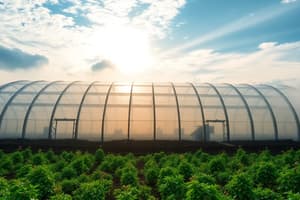Podcast
Questions and Answers
Which layer of the atmosphere is known for containing most of Earth's ozone and absorbing ultraviolet light?
Which layer of the atmosphere is known for containing most of Earth's ozone and absorbing ultraviolet light?
- Mesosphere
- Thermosphere
- Stratosphere (correct)
- Troposphere
The thermosphere is the coldest layer of the atmosphere.
The thermosphere is the coldest layer of the atmosphere.
False (B)
What process is responsible for producing oxygen on Earth?
What process is responsible for producing oxygen on Earth?
Photosynthesis
The atmosphere is composed of approximately ____% nitrogen.
The atmosphere is composed of approximately ____% nitrogen.
Match the following layers of atmosphere with their characteristics:
Match the following layers of atmosphere with their characteristics:
Which of the following gases changes concentration seasonally in the atmosphere?
Which of the following gases changes concentration seasonally in the atmosphere?
Albedo refers to the ability of a substance to absorb light.
Albedo refers to the ability of a substance to absorb light.
What is the main reason the mesosphere gets colder as altitude increases?
What is the main reason the mesosphere gets colder as altitude increases?
What is the relationship between temperature and particle speed?
What is the relationship between temperature and particle speed?
The dew point is the temperature at which the air is completely saturated.
The dew point is the temperature at which the air is completely saturated.
What is the formula for density?
What is the formula for density?
Air pressure at sea level is approximately _______ lbs per square inch.
Air pressure at sea level is approximately _______ lbs per square inch.
Match the following weather phenomena with their descriptions:
Match the following weather phenomena with their descriptions:
Which of the following statements is true regarding humidity?
Which of the following statements is true regarding humidity?
Wind always blows from areas of low pressure to high pressure.
Wind always blows from areas of low pressure to high pressure.
What is the main driver behind the movement of air, or wind?
What is the main driver behind the movement of air, or wind?
The process of water vapor turning into liquid water droplets in the atmosphere is called _______.
The process of water vapor turning into liquid water droplets in the atmosphere is called _______.
Which part of the Kinetic Molecular Theory (KMT) states that faster particles correspond to higher temperatures?
Which part of the Kinetic Molecular Theory (KMT) states that faster particles correspond to higher temperatures?
Flashcards
Convection Cell
Convection Cell
A stable pattern of rising and falling air caused by differences in temperature and density.
Greenhouse Effect
Greenhouse Effect
The process where certain gases in the atmosphere trap heat from the sun, warming the earth.
Temperature
Temperature
The average speed of all particles in a substance.
Humidity
Humidity
Signup and view all the flashcards
Saturation
Saturation
Signup and view all the flashcards
Dew Point
Dew Point
Signup and view all the flashcards
Air Pressure
Air Pressure
Signup and view all the flashcards
Density
Density
Signup and view all the flashcards
Wind
Wind
Signup and view all the flashcards
Precipitation
Precipitation
Signup and view all the flashcards
What is the composition of Earth's atmosphere?
What is the composition of Earth's atmosphere?
Signup and view all the flashcards
What is Photosynthesis?
What is Photosynthesis?
Signup and view all the flashcards
What are Variable Gases?
What are Variable Gases?
Signup and view all the flashcards
What is the Troposphere?
What is the Troposphere?
Signup and view all the flashcards
What is the Stratosphere?
What is the Stratosphere?
Signup and view all the flashcards
What is the Mesosphere?
What is the Mesosphere?
Signup and view all the flashcards
What is the Thermosphere?
What is the Thermosphere?
Signup and view all the flashcards
What is Albedo?
What is Albedo?
Signup and view all the flashcards
Study Notes
Composition of Air
- Air is a mixture of gases, primarily nitrogen (78%) and oxygen (21%).
- Argon and trace amounts of other gases make up the remaining percentage.
- Early Earth lacked oxygen, but photosynthesis produced it.
Layers of the Atmosphere
- Troposphere:
- Contains most of the atmosphere's mass.
- Weather occurs here.
- Temperature decreases with altitude.
- Extends 9-16 km (5-8 mi) above Earth's surface.
- Stratosphere:
- Chemical reactions absorb ultraviolet light.
- Contains most of the Earth's ozone.
- Temperature increases with altitude due to ozone absorption.
- Extends 50 km (30 mi) above Earth's surface.
- Mesosphere:
- Very thin, absorbs little sunlight.
- Temperature decreases with altitude.
- Meteors burn up here.
- Extends 85 km (52 mi) above Earth's surface.
- Thermosphere:
- Hottest layer.
- Extends 600 km (375 mi) above Earth's surface.
- Satellites and the ISS orbit here.
- Aurora Borealis (Northern Lights) occur.
- Exosphere:
- Outermost layer, gradually fades into space.
- No clear upper boundary.
Energy in the Atmosphere
- Temperature vs. Heat:
- Temperature measures the average speed of particles.
- Heat is the transfer of thermal energy from hotter to colder.
- Heat Transfer:
- Sunlight transfers thermal energy through space.
- Darker surfaces absorb sunlight, lighter surfaces reflect it.
- Albedo is the ability to reflect light; fresh snow has the highest.
- Conduction transfers heat when surfaces touch; atmosphere touches Earth.
- Convection involves rising (hot, less dense) and falling (cold, more dense) air. Creates convection cells.
- Greenhouse Effect:
- The atmosphere traps heat, maintaining temperatures suitable for life.
Temperature & Humidity
- Temperature:
- Measured in Celsius (°C).
- Water freezes at 0°C and boils at 100°C.
- Humidity:
- Amount of water vapor in the air.
- Warmer air holds more water vapor than colder air.
- When air is "full" (saturated), it cannot hold more water vapor.
- Relative humidity measures how close the air is to saturation.
- Dew point is the temperature at which water vapor condenses.
- Frost forms if dew point is below freezing.
Air Pressure
- Air pressure is the force exerted by air on a surface.
- Higher altitudes have lower pressure.
Density
- Density is mass per unit volume.
- Warm air is less dense; Cold air is more dense.
- Pressure affects air density.
Wind and Precipitation
- Wind:
- Movement of air caused by pressure differences
- Blows from high to low pressure
- Speed affected by pressure difference, obstacles (hills, buildings).
- Precipitation:
- Water falling from the atmosphere (rain, hail, sleet, snow).
- Forms when water vapor condenses into liquid or solid water.
- Hail: raindrops frozen repeatedly during their ascent and descent, causing them to increase in size.
- Sleet: rain that freezes on its way to the ground.
- Snow: water vapor converting directly to ice crystals.
- Coalescence: raindrops growing larger as they collide
Water Cycle (Simple)
- Evaporation (A): Liquid water turns into vapor.
- Condensation (B): Water vapor turns back into liquid water.
- Precipitation (C): Liquid or solid water falls from the clouds.
- Runoff (D): Water flows over the ground.
Studying That Suits You
Use AI to generate personalized quizzes and flashcards to suit your learning preferences.




